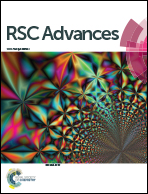Removal of rhodamine B from a water medium using hydroxyl and sulphate radicals generated by iron loaded activated carbon
Abstract
Iron loaded activated carbon (IAC) was used as an effective heterogeneous catalyst for generating hydroxyl (via Fenton reactions) and sulphate radicals (via persulphate oxidation), and it tested for the degradation of rhodamine B (RhB) from a water medium. The loading of iron was characterized by SEM, N2 adsorption–desorption isotherm analysis and XRD techniques, and an effective loading of iron oxides over the activated carbon (AC) was observed. The effects of catalyst amount, persulphate concentration, dye concentration, and solution pH on the dye removal efficiency were analyzed. Compared to Fenton oxidation (FO), persulphate oxidation (PO) of dye was found to be very effective at all the tested conditions. The RhB removal efficiencies at pH 3, 6 and 9 were 92.5%, 95% and 93%, respectively, for FO and 99%, 96% and 98%, respectively, for PO. More than 40% mineralization efficiency was observed for both the processes at the optimal conditions. The removal of RhB occurred by degradation of the chromophore ring in the presence of hydroxyl radicals, whereas the dye removal occurred by de-ethylation in the presence of sulphate radicals. At lower pH condition, the sorption of dye over AC was very less, indicating effective dye degradation. The results indicate that IAC is an effective catalyst for dye degradation from an aqueous solution.


 Please wait while we load your content...
Please wait while we load your content...